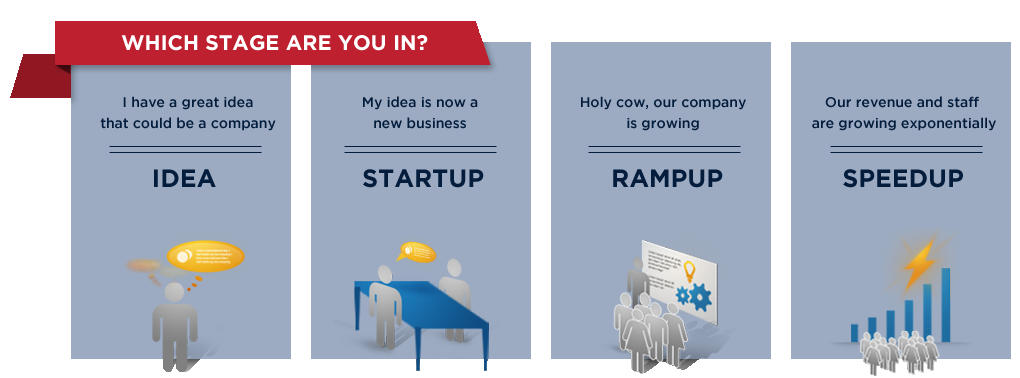For readers who really pay close attention to detail, you might have noticed that I’ve removed entrepreneurism as one of the topics this blog will cover in the future. It’s not that I’m uninterested in the subject; after all, I remain at heart an entrepreneur. Because this is a corporate blog, I’ve decided to concentrate on topics more closely related to areas in which my company deals, namely: technology, business, and government with a focus on supply chain management, artificial intelligence, and innovation. Therefore, this will be my final post directly dealing with the subject.
Earlier this year, I noted that the Obama administration had hopped aboard the entrepreneurial bandwagon. In late January, it “announced a string of initiatives—collectively called ‘Startup America’—designed to spur innovation and growth at private U.S. firms.” [“Kickstarting Entrepreneurship With ‘Startup America’,” by Colleen DeBaise, Wall Street Journal, 1 February 2011]. Months later “a major part of the initiative” has finally been implemented. [“Long-Awaited Startup America Program Opens for Business,” by Emily Maltby, Wall Street Journal, 26 September 2011] Maltby reports:
“The initiative is made up of a series of public-private programs designed to spur small-business growth. The two operations of Startup America have different missions to accomplish the same goal – boost entrepreneurship and job creation. On the private side, a number of initiatives have rolled out over several months including classroom and mentorship programs provided by nonprofits and corporations. But the principal agenda for entrepreneurs, called the Startup America Partnership, launched only [in September]. It is now allowing entrepreneurs to apply for free or discounted products and resources such as Google Adwords, Intuit payroll services and Salesforce technology. Collectively, there are more than 25 partners who have pledged $730 million worth of in-kind resources to help small firms grow.”
If you’re interested in the program (or, more importantly, if you want to advantage of the program), you should click on the link above and check out the website. It’s a straight forward, user-friendly site. As the attached graphic from the site shows, you might be able to find help regardless of the stage of the process you are currently at.

Explaining why it took so many months to get up and running, Scott Case, chief executive of the Startup America Partnership, told Maltby, “We’ve spent the last six months recruiting partners. Now, we’re open for business.” Maltby continues:
“The partnership is currently accepting applications and is looking to admit 100,000 high-growth start-ups (incorporated firms, usually with at least two founders and with plans to hire and grow); 10,000 ramp-ups (with five employees and a revenue stream); and 1,000 speed-ups (typically 25 or more employees). Sole proprietorships, freelancers, independent consultants and aspiring entrepreneurs with no more than an idea are less likely to be accepted, says Case.”
So what does the Startup America Partnership actually do? Its website explains the Partnership this way:
“Entrepreneurs are at the heart of the Startup America Partnership. We’re bringing together a coalition of mentors, advisors, funders, major corporations and service providers to deliver strategic and substantive resources to help entrepreneurs start and scale companies. The Startup America Partnership is:
“- A movement by entrepreneurs, for entrepreneurs – launched January 31, 2011, at the White House to help inspire and celebrate entrepreneurs, their firms and the people that join them.
“- An independent, private-sector entity – leveraging the work of our close partners in the U.S. government, but with the fierce freedom, independence and agility that define American startups themselves. Focused on bringing the private sector together to maximize the success of America’s entrepreneurs – and maximize America’s competitiveness in an increasingly global world.
“- A tool to showcase a wide range of entrepreneurs, elevating them as innovators and job creators, while celebrating entrepreneurship as a core American value. We aspire to make starting or joining an American startup the most desirable job in the world.
“Our ‘customers’ are the entrepreneurs themselves. We will take steps to encourage the creation of new startups, however, our principal focus will be on supporting the entrepreneurs who are leading existing firms with high-growth potential (what we call ‘speedups’).”
Given the current high level of unemployment in America, the Partnership’s focus on creating jobs is not only natural but needed. The site goes on to explain how the Partnership is going to support “speedups” to become even more successful. It says:
“We will do this by assembling commitments from a wide range of companies and organizations to provide assistance to entrepreneurs in the following areas:
“Expertise: Connect entrepreneurs with training, mentors, advisors and accelerators
“Services: Provide entrepreneurs access to critical services at reduced costs
“Talent: Assist entrepreneurs in recruiting and training the people that can help them grow
“Customers: Help to scale startups through new and existing markets
“Capital: Highlight sources of capital available to entrepreneurs in various regions and sectors
“Through quality resources provided by our partners, we’re going to help more startups accelerate their growth and become speedups. We’re gathering a suite of resources to help them smartly grow their organizations, expanding from dozens of employees to hundreds and someday thousands.”
With millions of jobs needed in the U.S. at the moment, the faster companies can move from hiring dozens to hiring thousands the better the country will be. Maltby continues her article with an explanation of what the Startup America initiative is doing in the public sector. She writes:
“On the public side, the administration is focused on creating policy and programs on the municipal level that can help small firms grow. The Small Business Administration has facilitated the launch of new state funds to help with capital access, mentorship programs and roundtables throughout the country to get input from entrepreneurs on how to eliminate burdensome government barriers. (That feedback is now being considered by various federal agencies and is available for public review.) Government agencies have also launched numerous competitions, such as the $12 million i6 Green Challenge and the $37 million Jobs and Innovation Accelerator Challenge to help regional industry clusters across the U.S. The latter announced its winners last week.”
The press release that announced the winners of the Jobs and Innovation Accelerator Challenge noted that the winning “public-private partnerships are expected to create more than 4,800 jobs and 300 new businesses, as well as retain another 2,400 jobs and train approximately 4,000 workers for careers in high-growth industries.” If the estimates hold true, the government would have spent approximately $5200 to create or retain each job. That’s not a bad investment. If you add in the extra 4000 workers who could fill openings that already exist in high-growth industries, the average investment per job is only $3300. The press release reports that “each of the 20 awards average about $1.8 million per project, and winning clusters will contribute another $13 million in total matching funds.” The winners were:
- Rockford, IL: Rockford Area Aerospace Cluster
- Southeast, MI: Southeast Michigan-Advanced Energy Storage Systems Initiative
- Pittsburgh, PA: Southwestern Pennsylvania Revitalization
- Northeast, OH: Northeast Ohio Speed-to-Market Accelerator
- FL: Space Coast Clean Energy Jobs Accelerator
- Knoxville & Oak Ridge, TN: Advanced Composites Employment Accelerator
- Milwaukee, WI: Milwaukee Regional Water Accelerator Project
- MO and KS: KC Regional Jobs Accelerator
- GA: Atlanta Health Information Technology Cluster
- AR, MO, OK: The ARK: Acceleration, Resources, Knowledge
- St. Louis, MO: St. Louis Bioscience Jobs and Innovation Accelerator Project
- OR and WA: Portland Regional Clean Tech Advance Initiative
- San Diego, CA: San Diego-Imperial Valley Renewable Energy Generation Training and Demonstration Center
- Puget Sound, WA: Washington Interactive Media Accelerator
- Hudson Valley, NY: New York Renewable Energy Cluster
- Finger Lakes, NY: Finger Lakes Food Processing Cluster Initiative
- MT, ND, SD: Upper Missouri Tribal Environmental Risk Mitigation
- South Central, KS: Center for Innovation and Enterprise Engagement
- Northeast, MN: Minnesota’s Mining Cluster
- Northern, Maine: GreenME
If you are interested in knowing more about why “clusters” are important, read my post entitled The Birth and Death of Industry Hubs. Charles R. Schwab, founder and chairman of the Charles Schwab Corporation, also believes that encouraging entrepreneurism is important. In a recent op-ed piece, he wrote, “We can spark an economic recovery by unleashing the job-creating power of business, especially small entrepreneurial businesses, which fuel economic and job growth quickly and efficiently. Indeed, it is the only way to pull ourselves out of this economic funk.” [“Every Job Requires an Entrepreneur,” Wall Street Journal, 28 September 2011] Sparks only work when fuel and oxygen are also present. For the economy, the fuel is demand and oxygen is resources. Schwab correctly points out that “we cannot tax our way out of this. We cannot artificially stimulate our way out of this. We cannot regulate our way out of this.” So how do we get out of this morass? I guess we “ask Chuck.” He continues:
“What we can do—and absolutely must—is knock down all hurdles that create disincentives for investment in business. Private enterprise works. I founded Charles Schwab in 1974, when America was confronting a crisis of confidence similar to today’s. We had rapidly rising inflation and unemployment, economic growth grinding into negative territory, and paralyzed markets. The future looked pretty bleak. Sound familiar? Yet I had faith that our economy would recover. My vision was simple: Investors deserve something better than the status quo. I launched the company with four employees, a personal loan on my home, and an audacious dream. I didn’t know exactly how we were going to do it, nor could I foresee that over the decades we would end up building a business that serves over 10 million accounts. But we went for it.”
I agree with Schwab that it is private sector businesses that generate both jobs and wealth, not the government. He looks at his own story for evidence of “the potential power of the entrepreneur’s simple leap of faith.” He asserts, “The success of a single business has a significant payoff for the economy.” As evidence he once again references his own company. My only problem with using a financial sector example is that many people credit the financial sector for the current recession. Robert J. Samuelson reports that U.S. “households have lost $7 trillion in wealth, mostly from lower home and stock prices.” [“Job Creation 101,” Washington Post, 11 September 2011] Nevertheless, Schwab’s larger point is valid — investment in businesses is critical for economic growth. A single business, he reminds us, buys “services and products from other companies in a diverse set of industries, from technology to communications to real estate to professional services” and in doing so helps “suppliers create businesses and jobs.” As I’ve noted before, the biggest bang for the buck comes when a manufacturing job is created. Estimates are that 8 supply chain jobs are created along with it. Schwab concludes:
“The simple fact is that every business in America was started by an entrepreneur, whether it is Ford Motor Co., Google or your local dry cleaner. Every single job that entrepreneur creates requires an investment. And at its core, investing requires confidence that despite the risks, despite the hard work that will certainly ensue, the basic rules of the game are clear and stable. Today’s uncertainty on these issues—stemming from a barrage of new complex regulations and legislation—is a roadblock to investment. We have to clear that uncertainty away. … Republicans and Democrats … need to review every piece of existing legislation and regulation with a clear eye to what impact it will have on business and growth. If something is a job killer, put a moratorium on it. Stop adding to the litany of new laws and regulations until we’ve had time to digest those in place and regain some certainty about the future. Proposed laws and regulations should be put to a simple test: What will this do to encourage businesses and entrepreneurs to invest? What will it do for jobs?”
Back during the earliest stages of the Great Recession, I recommended that Schwab’s final question be asked about every piece of stimulus legislation that was being proposed. Unfortunately, Congress joined the Bush and Obama administrations in following a different path and massive job losses were the result. They now appear clueless about how to get the country out of the current morass. Not all regulation is bad; but I agree with Schwab that job killing regulations need to be identified and nullified.




